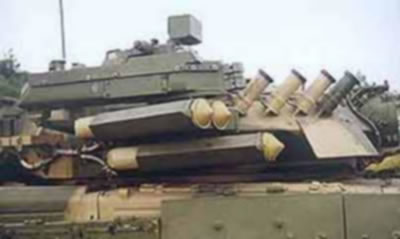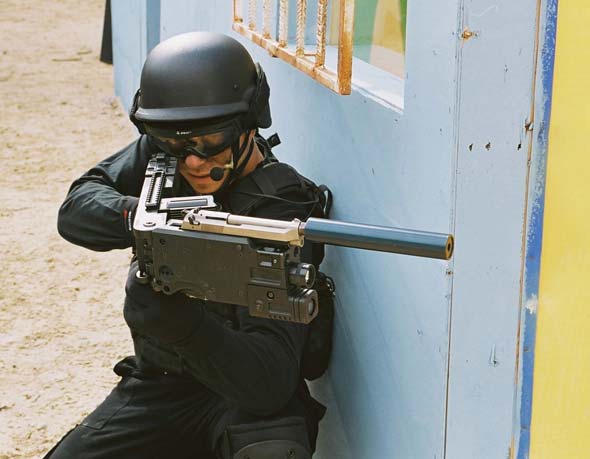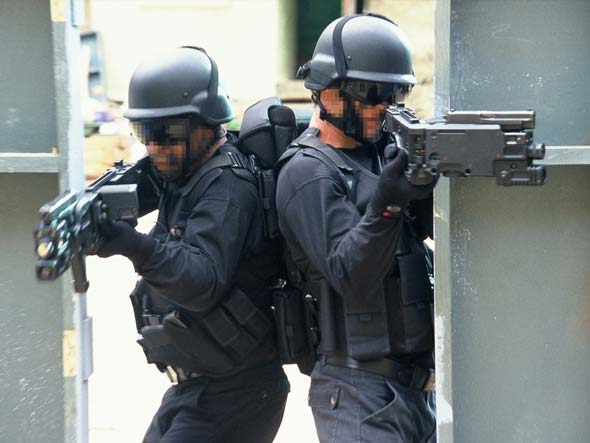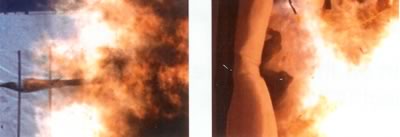BirdEye 100, a miniature UAV that can be operated by a single soldier was developed by IAI under an IDF conceptual study. The BirdEye 100 is back packable, hand launched and ready for operation within a few minutes. The UAV can be operated at lower echelons and directly serve small infantry and armored units by providing them live video and over the hill intelligence. BirdEye 100 flies autonomously toward designated waypoint, as its mission is planned and controlled by clicking waypoints over a digital map displayed on the ground mission laptop computer. The small plane is powered by an electrical motor and can fly for about 1 hour. Communication for video and data link can be maintained for about 5 Km. The aircraft takeoff weight is about 1.3 Kg. The wingspan is 85 cm and length is 80 cm.
Combat Laser Guided Anti-Tank Missile
The Combat missile is an advanced, extended range missile which can be fired through the 125mm gun of the T-80UD, T-84, T-72AG, B and C models. The missile is composed of separate head and tail sections which are stored separately but loaded and combined as a unified cartridge, designed for the automatic loaders of the individual tanks (T-72 or T-80).
The laser (beam riding) missile can be fired on the move, at speeds of up to 30km/h and engage stationary or moving targets at speeds up to 70 km/h. the missile uses tandem shaped charge warhead and due to its guidance system, can penetrate both active, reactive and passive protection systems. The high precision of the missile enables effective engagement of point targets such as protected positions, helicopters and other targets. The system’s range is 5,000 and target engagement at this range will take 17 seconds.
Battlefield Identification System (BCIS)
An encrypted question and answer system using millimeter wave (38GHz) technology to identify friendly vehicles in less than a second, out to ranges of 5,500 meters. Such device Affords the gunner critical shoot-or-no-shoot information during combat, interlinked with the firing procedure. If the target is equipped with BCIS, the gunner taking aim will receive a flashing red dot in his optical sight combined with audio voice signal “Friend”; if it is not equipped the gunner will receive response “Unknown” in order to take further action. Unfortunately, BCIS was scrapped by Pentagon in 2001.
DROZD Hard-Kill Active Defense System
The first and probably the world’s only operationally deployed APS developed by the Russian KBP company was the 1030M Drozd (Thrush), which was first installed on a T- 55AD MBT in 1983s. The automatic system is capable of defeating anti-tank guided missiles and grenades, approaching at speeds between 70 to 700 meters per second. The system employed eight 107mm anti-missile rockets, triggered by a pair of millimeter-wave radar sensors mounted on either side of the turret facing forwards. This configuration utilized the turret traverse to slew the protective devices into position. The rockets use time delay fuzing to activate a fragmentation charge at a safe distance from the tank.
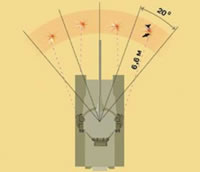 It is assumed that each radar sensor and rocket quad covers 40 degrees of the frontal arc. with an elevation of -6 +20 degrees. The rockets can be fired at any direction the turret points at, and rely on the the radar for early warning, target detection and intercept parameters (speed and direction). The original Drozd two quad-round launchers, utilizing four High Explosive Fragmentation charges, weighing 19kg each. The total system’s weight is below 1,000kg. To provide 120 degrees coverage, Drozd-2 system was proposed, with five twin-rocket launch tubes and sensors mounted on different locations. The system is currently offered for the upgraded version of the T-80U. It is also proposed for the “Black Eagle” project.
It is assumed that each radar sensor and rocket quad covers 40 degrees of the frontal arc. with an elevation of -6 +20 degrees. The rockets can be fired at any direction the turret points at, and rely on the the radar for early warning, target detection and intercept parameters (speed and direction). The original Drozd two quad-round launchers, utilizing four High Explosive Fragmentation charges, weighing 19kg each. The total system’s weight is below 1,000kg. To provide 120 degrees coverage, Drozd-2 system was proposed, with five twin-rocket launch tubes and sensors mounted on different locations. The system is currently offered for the upgraded version of the T-80U. It is also proposed for the “Black Eagle” project.
CornerShot
CornerShot is a special purpose weapon, designed specifically for “round the corner” fire engagements. The weapon is composed of a forward swiveled pistol mount, attached to a specially designed gun frame. The frame has a video display that can be flipped into viewing position, while the pistol and the camera attached and adjusted to its line of fire are exposed around the corner.
This weapon was designed for SWAT and Special Forces operations, where missions frequently require entering into a space occupied by armed hostiles. This weapon can safely eliminate such hostiles by accurate fire, without exposing the assault team to enemy fire. According to CornerShot, the company also designed a version of the weapon that can fit an automatic assault weapon such as an M-16 but this version was not displayed yet.
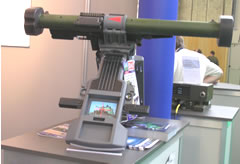 A derivative of the system is also developed for anti-tank weapons. A first impression of such design was on display by Dynamit Nobel at Eurosatory 2004. The system enables target acquisition and firing thePanzerfaust anti-tank rocket system, behind obstacles, where the weapon is aimed at the target exposed, while the operator controls it around a corner or protected by a wall or other barrier. In 2006, Cornershot launched an assault rifle version of the weapon.
A derivative of the system is also developed for anti-tank weapons. A first impression of such design was on display by Dynamit Nobel at Eurosatory 2004. The system enables target acquisition and firing thePanzerfaust anti-tank rocket system, behind obstacles, where the weapon is aimed at the target exposed, while the operator controls it around a corner or protected by a wall or other barrier. In 2006, Cornershot launched an assault rifle version of the weapon.
Laser Dazzler – Laser Active Countermeasures
The Chinese opted to equip their new Type 98 with a different countermeasure suite, based mainly on defeating ATGM, by the use of directed high power laser. A typical is the JD-3 “Dazzler” system comprises of laser warning devices, a dome shaped sensor installed on the turret’s roof-top, and a box shaped Laser Self Defense Weapon (LSDW) which “fires” a laser beam at the illuminating source, either a tank gunner, helicopter or missile launcher. The system employs two modes of operation – the low power mode is used at the general direction of the threat, in a search pattern designed to locate the target’s optics. Once locked on a target, the laser switches to high power mode, to defeat the target by blinding the operator or saturating its electro-optical circuits.
RASS Rapid Armored Shelter System
RASS Enabled rapid assembly of fortified (bullet proof) constructions in various forms and shapes, by joining two basic shapes – square panels weighing 18kg each and triangular (8kg weight). The basic panel provides protection against fragments with velocities of up to 600m/s; for protection against small arms fire, a double-panel system would be typically be used.
F-16 E/F (Block 60)
The first order for 80 F-16 Block 60, which has been designated the F-16E/F version, was received from the air Force of the United Arab Emirates (UAE) in early 2000. First production deliveries of the UAE aircraft are slated for April 2004. The F-16E/F resembles earlier F-16 aircraft in appearance only. Internally, the new model has an all-new cockpit that features all-digital instruments and three 5×7-inch color displays, HUD and helmet mounted sight and display. Additionally, the F-16E/F features a new avionics suite with highlights including a revolutionary Electronic Warfare (EW) system, the new APG-80 Agile Beam Radar (ABR) and a new Integrated FLIR Targeting System (IFTS), all provided by Northrop Grumman.
The aircraft is powered by a General Electric F110-GE-132 engine that produces 32,500 pounds of thrust. The new engine was flight tested on modified USAF F-16C at the Air Force Flight Test Center, Edwards Air Force Base, Calif. The new engine version features “blisks” (bladed-disks) in the three-stage modular fan section in lieu of traditional blades to improve performance and maintainability. The engine also incorporates an enhanced durability radial augmentor (afterburner) and exhaust nozzle, plus control software modifications to optimize engine performance at all flight conditions. The Block 60 aircraft and engine also will feature an auto-throttle capability.
Bigliani Class V – Fast Patrol Boat
Built by: Intermarine / Rodriquez Cantieri Navali Group
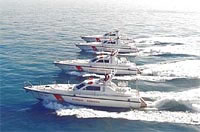 Intermarine, a member of the Rodriquez Cantieri Navali group has introduced the Bigliani Class V fast patrol boats family, including the V6000, 16.5m interceptors capable of a speed of 70 knots, and a similar model, V5000, an armed version develops a speed in excess of 50 knots. A larger, 25 meter boat, constructed from aluminium is offered with a combined propulsion which consists of two lateral props and one booster waterjet, developing a sustained speed in excess of 34 knots. Another design, the MV85, is a 27m boat, constructed of composites.
Intermarine, a member of the Rodriquez Cantieri Navali group has introduced the Bigliani Class V fast patrol boats family, including the V6000, 16.5m interceptors capable of a speed of 70 knots, and a similar model, V5000, an armed version develops a speed in excess of 50 knots. A larger, 25 meter boat, constructed from aluminium is offered with a combined propulsion which consists of two lateral props and one booster waterjet, developing a sustained speed in excess of 34 knots. Another design, the MV85, is a 27m boat, constructed of composites.  Armed with a 30mm gun it is designed to sustain a speed in excess of 42 knots. The largest patrol boat from Intermarine is the MV115, a 35m boat, equipped with two 2560 kw MTU diesel engines they can reach a maximum speed of 35 knots with 135 tons full load displacement. The boat will are constructed from composite materials, with antiballistic protection Kevlar and will be armed with an Oto Melara 30 mm gun. The company is currently constructing three 35 m’ and ten 27 m’ V class boats for the Italian Custom authority, scheduled for delivery by 2005.
Armed with a 30mm gun it is designed to sustain a speed in excess of 42 knots. The largest patrol boat from Intermarine is the MV115, a 35m boat, equipped with two 2560 kw MTU diesel engines they can reach a maximum speed of 35 knots with 135 tons full load displacement. The boat will are constructed from composite materials, with antiballistic protection Kevlar and will be armed with an Oto Melara 30 mm gun. The company is currently constructing three 35 m’ and ten 27 m’ V class boats for the Italian Custom authority, scheduled for delivery by 2005.
Lightweight Armor-Piercing Multi-Hit Insert (LAPMI)
Lightweight Armor-Piercing Multi-Hit Insert (LAPMI), a follow-on to the combat proven Small Arms Protective Insert (SAPI) currently produced by Simula. While SAPI is already providing good protection against the most common threats (over 250,000 already deployed), manufacturers are seeking weight saving, improved ballistic performance, especially multi-hit durability, and improved comfort. LAPMI weighs up to 1.70 – 3.25 kg (depending on size) and offers three-shot multi-hit protection against 5.56x45mm AP, 7.62x51mm (M80) FMJ ball round, 7.62x54R mm type LPS Dragunov round and 7.62mm APM2 armor piercing rounds. Its multi-curved geometry and modular design enable effective fit for most users, both male and female. Logistical advantages include a common design for fore and back inserts, high durability to drop and vibration, and improved resistance after exposure to hot or cold temperatures, diesel fuel, water or oil and direct fire.
IABS – RPG Active Countermeasure
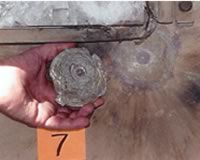 IABS combines an inexpensive radar sensor and airbag systems which are inflated before the RPG hits the protected vehicle. The airbag disrupts the shaped charge fuse, as the projectile collapses upon itself, jamming the time-out fuse, thus defusing the shaped charge before it hits the vehicle’s skin.
IABS combines an inexpensive radar sensor and airbag systems which are inflated before the RPG hits the protected vehicle. The airbag disrupts the shaped charge fuse, as the projectile collapses upon itself, jamming the time-out fuse, thus defusing the shaped charge before it hits the vehicle’s skin.
During tests, the system was installed on up-armored Humvees doors, and demonstrated effective protection of the crew compartment. IABS was also effective in protecting the transparent armor (windows) which were broken, but were not penetrated by the RPG.
ASPS Self Defense System
Advanced Self Protection System (ASPS), a new generation of self-defense system, developed by Elisra Electronics Systems. The system includes both passive and active subsystems, and incorporates, for the first time of an F-16, both full azimuth coverage RWR and passive (EO) Missile Warning System (MWS). The system can detect pulse, CW, High PRF and Pulse Doppler signals, discriminate them from interference and prioritize the most threatening ones. The system points at a valid threat both visual and audible means. The MWS can also track a threat throughout the engagement. After detecting a missile threat, by its infrared signature, filters the background clutter by a narrow spectral window optimized to real-time signal, by an adaptive threshold. The threat assessment is determined by a after a rapid target algorithm, which tracks each threat frame-by-frame, analyzes target maneuverability, relative position, inertial data and angular velocity and intensity.
By using infrared imagery and signal processing, PAWS-2 detects and tracks incoming missile’s hot plume as it appears within a protective sphere surrounding the aircraft. The system discriminates between threatening and non-threatening missiles, by evaluating the missile’s trajectories. When it detects a threatening missile, PAWS-2 alerts the aircrew with a warning signal and automatically activates countermeasures such as flares and DIRCM. The ASPS’ active subsystem (jammer) can be used against enemy radars and radar guided threats. The system can employ a rich repertoire of deceptive signals, at various frequencies and power levels, to employ Doppler, range, AM and various noise techniques. The system is also integrated with the Advanced Countermeasures Dispensing System (ACDS) built by BAE Systems’ Israeli based subsidiary (formerly Rokar International). ACDS controls and dispenses various types of countermeasures, including chaff, flares and RF decoys produced by IMI, that adapt to the various phases of the engagement parameters. Special designs allows the ACDS to fire dual chaff cartridges double the number of on-board chaff stores per mission, and fire multi-spectral flares to response or a stronger decoy signal. The EW cockpit displays are provided by the Terma.
ARENA-E Active Protection System for AFV
A more complete hemispheric protection is the Russian Arena E – developed by the Russian company KBM. The system is designed to protect the tank from attacks of anti-tank guided missiles launched from the ground and by attack helicopter and lightweight anti-tank grenades (such as RPG). The system weighs between 1 – 1.3 tons (depending on the coverage and configuration) and uses a fixed, omni-directional radar, that covers a sector of 220 – 290 degrees around the tank. The protective charges are housed in a “belt” of 22-26 protective charges (depending on the turret size and shape), each positioned to cover a specific sector. Once an incoming threat is detected by the radar, the system ejects a charge above and sideways from the tank, to a position best suited for intercepting the target. As the charge explodes, it throws a deadly hail of fragments downward, to shutter and destroy the incoming projectile.
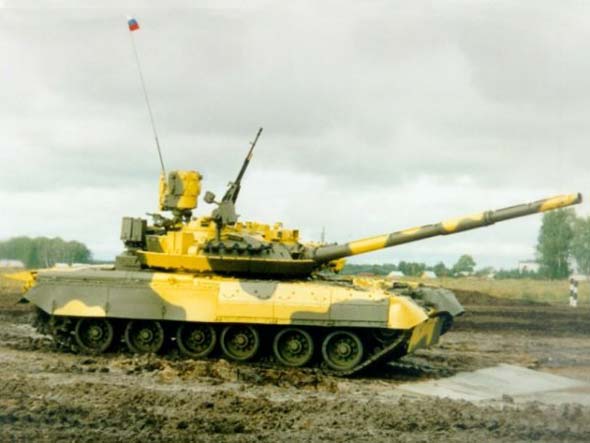
The system is capable of engaging incoming missiles, at speeds ranging from 70 to 700 meters per second. The system creates a virtual “cone” shaped shield at a radius of 20-30 meters from the tank, and its response time, from target detection to destruction is 0.07 seconds. When the system is triggered, a warning signal is activated, to warn infantrymen that may be following the tank to open some distance or take cover. The status of the Arena E system is unclear, although the system was seen in public since the mid 1990s, it is believed that funding problems delayed final development and deployment of the system.
While Arena-E provides an effective protection against many types of anti-tank threats, from RPGs to fast missiles such as Hellfire and TOW, it cannot defeat fast missiles (such as HVM) and tank projectiles, such as HEAT shaped charge projectiles and APFSDS penetrators. Different countermeasures are being examined to defeat these threats, including the deployment of steel bars, which are accelerated into the projected flight path of the incoming projectile. The kinetic energy discharged from the collision between the steel bar and the projectile can disintegrate or destabilize the projectile, shift it from its course, or cause it to hit the target at angles that do not facilitate effective penetration.
Aramid Fiber
Aramid fiber (1961) is a synthetic, fire-resistant polyamide fiber, extensively used in the aerospace and military for structural formations, asbestos substitutes and ballistic protection. Derivatives of the original aramid are Para-aramid fibers, such as Kevlar (also produced as Twaron). Military applications of aramid fibers are in flame resistant clothing, protective vests and helmets, and various composite materials.

